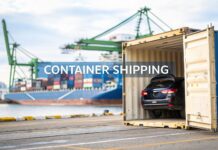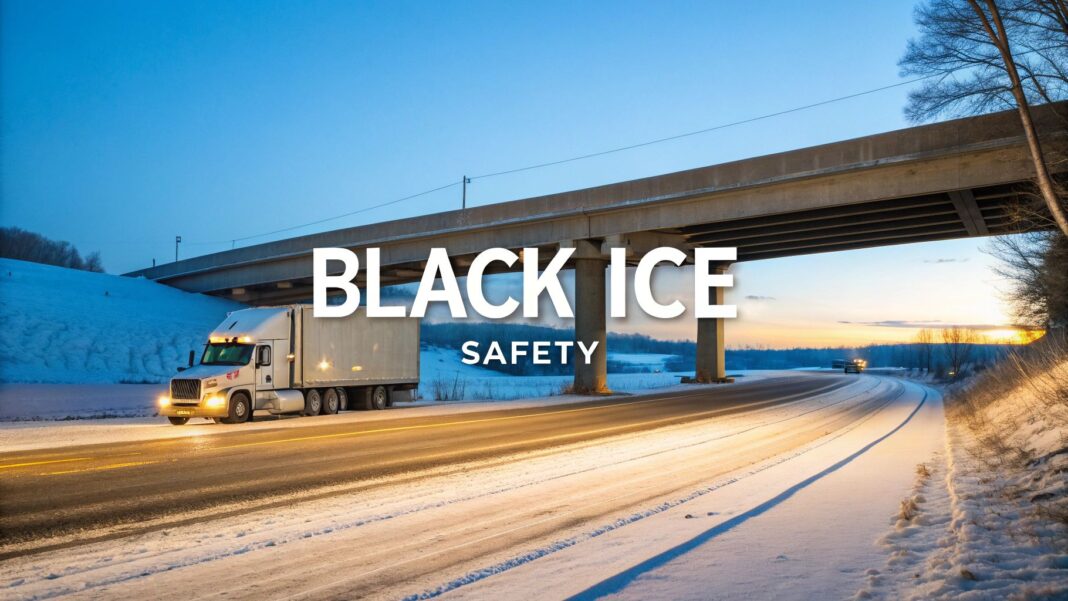
When a rig hits black ice, it's not just an accident; it's a catastrophic failure of friction. A black ice truck crash happens when that invisible, paper-thin layer of ice sends an 80,000-pound machine skidding out of control. It’s a transport professional's nightmare because it turns a road that looks merely wet into a skating rink without warning. This silent hazard is a significant operational risk for any fleet during the winter months.
Understanding the Unseen Threat of Black Ice
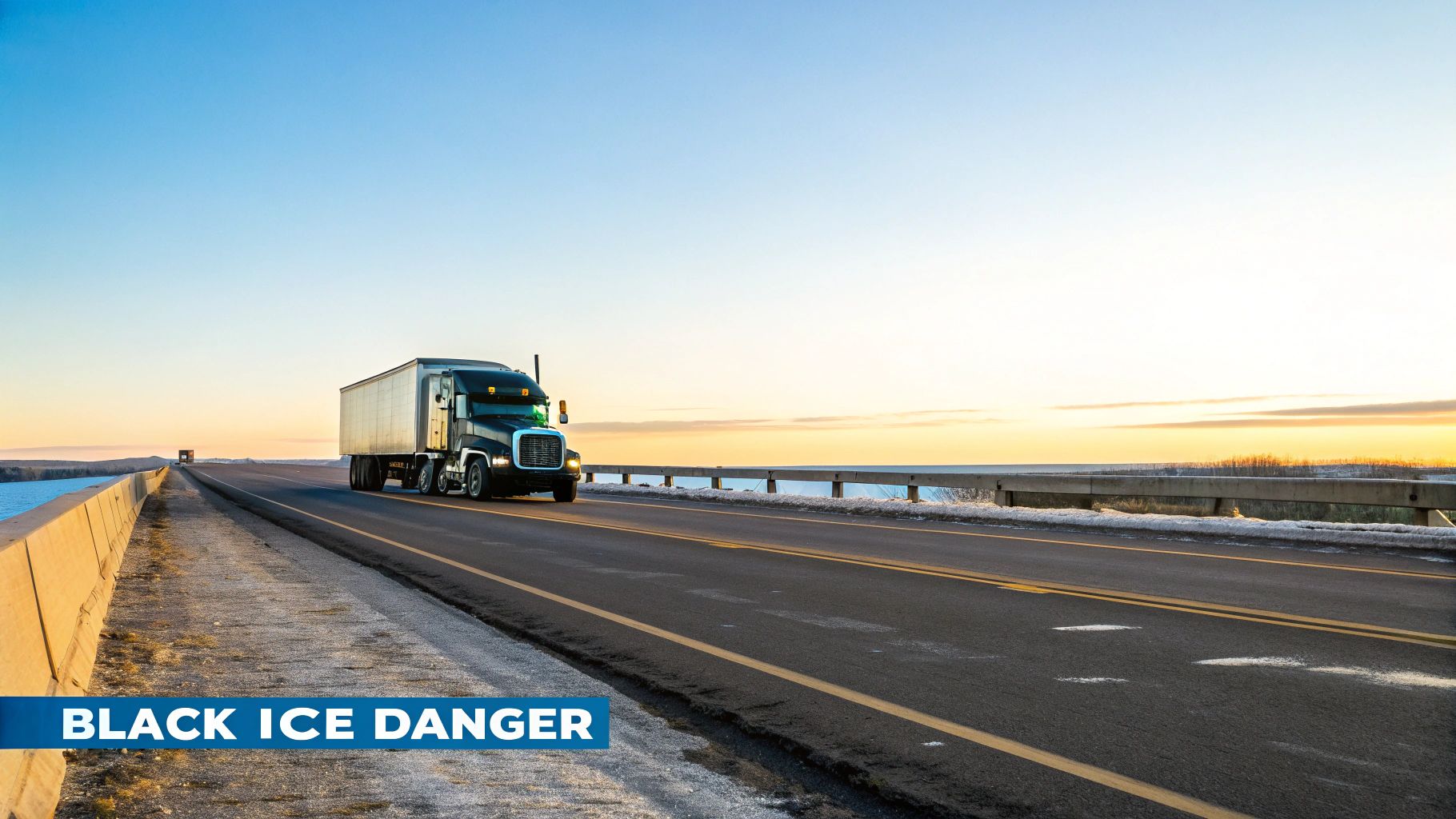
For transport professionals, black ice is a critical variable that can end careers and halt supply chains. The danger lies in its deceptive nature. It forms silently on pavement that appears safe, perhaps just damp, instantly eliminating tire grip and driver control.
The physics are simple but carry severe consequences for transport operations. Black ice forms when moisture freezes into a slick, transparent glaze. Drivers must be highly vigilant in these predictable high-risk zones:
- Bridges and Overpasses: These structures are exposed to cold air from above and below, causing them to freeze much faster than ground-level roadways. They are the first to ice over and the last to thaw.
- Shaded Road Sections: Any stretch of road shielded from direct sunlight by trees, cliffs, or buildings is a prime location for ice. These areas can remain frozen all day.
- Low-Lying Areas: Cold air is dense and settles in valleys and dips. This creates microclimates where moisture can freeze, particularly in the pre-dawn hours when temperatures are lowest.
Why Trucks Are Uniquely Vulnerable
The mass and momentum of a commercial truck amplify the danger of a skid. An 80,000-pound rig has immense inertia, rendering standard stopping distances obsolete on an icy surface. Once a trailer begins to slide, a jackknife becomes an immediate and often unrecoverable threat. These dynamics are a core consideration in heavy vehicle logistics, as detailed in our guide on https://www.wewilltransportit.com/hauling-trucks/.
The impact of a black ice incident is severe. A January 2022 pileup on a South Korean highway, attributed to black ice, involved approximately 40 vehicles and resulted in multiple fatalities. This incident underscores the extreme risk of losing control of a heavy vehicle.
A loaded truck doesn't just slide on black ice; it becomes an uncontrollable force. The weight that provides stability under normal conditions becomes a liability, amplifying any minor loss of traction into a full-scale emergency.
Building Proactive Awareness
The most effective strategy against black ice is anticipation, not reaction. This requires a shift in mindset from reacting to hazards to proactively identifying them on every winter haul. Enrolling in specialized defensive driving courses is a valuable investment. These programs teach drivers how to interpret environmental cues and spot potential dangers long before they become critical, a skill that separates elite professionals from preventable statistics.
Mastering Your Pre-Trip Winter Inspection
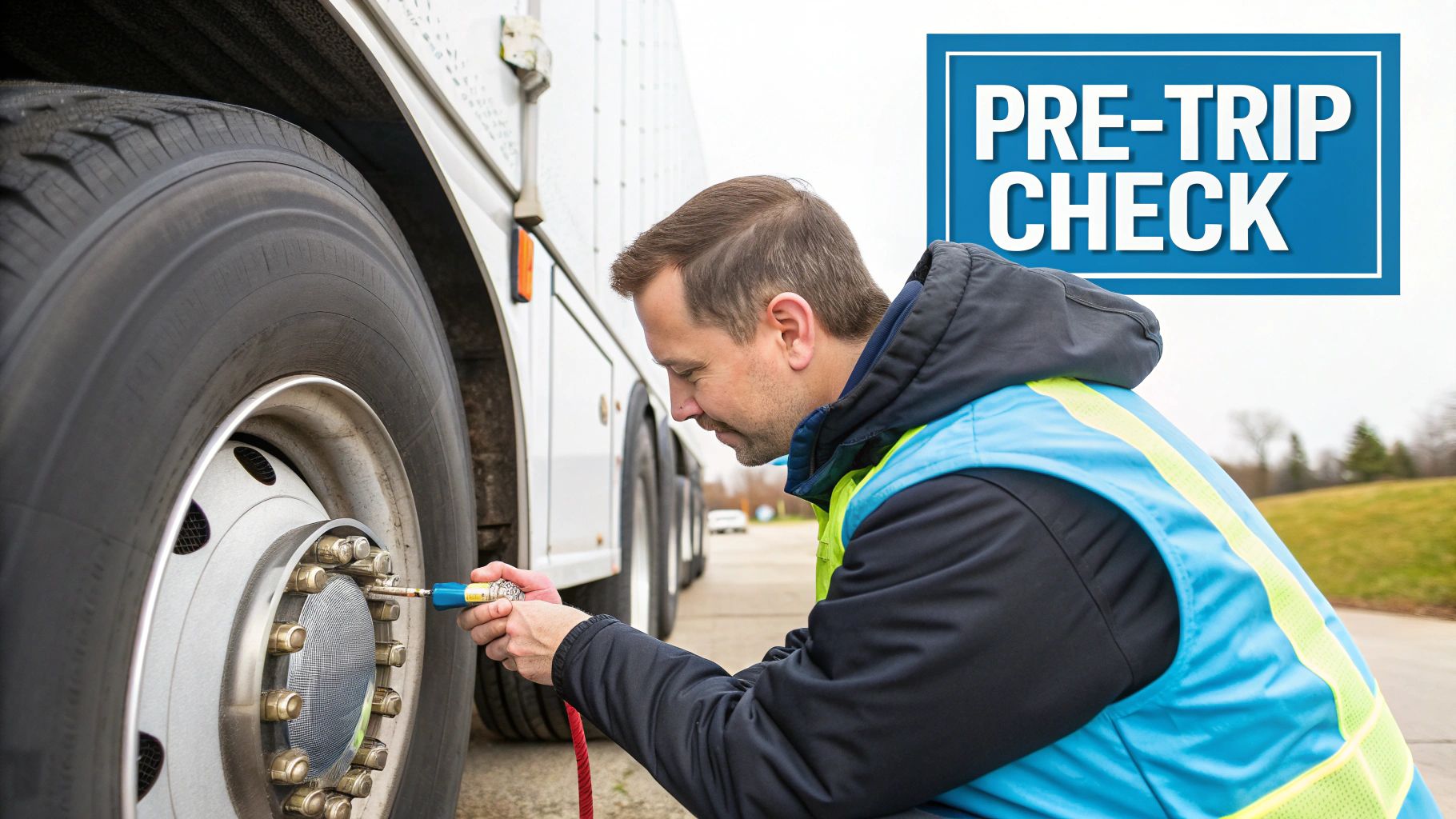
Effective management of a black ice threat begins in the yard before the trip starts. A standard pre-trip inspection is insufficient when temperatures drop. Your inspection must be conducted through a winter-specific lens, focusing on ice, cold, and visibility.
The goal is to focus on systems that are critical when traction is lost. Tires, brakes, and lights become your primary safety equipment. Overlooking details in the pre-trip phase is a critical error in risk management for winter transport.
Beyond the Basics: Tire and Brake Integrity
Cold air directly impacts tire pressure. For every 10°F drop in ambient temperature, tires can lose 1-2 PSI. A pressure reading that was correct in a heated workshop may be dangerously low in a freezing yard. Underinflated tires have a compromised contact patch, significantly reducing the grip necessary to control a skid on ice.
Tire condition is equally critical. Research indicates that while 76% of Americans have driven on black ice, many drivers underestimate the importance of winter-rated tires. For a commercial vehicle, this is an unacceptable risk. You can review the full study on driving habits at Automotive-Fleet.com.
Your pre-trip isn't just about compliance; it's about anticipating failure points. In winter, every potential weakness in your rig is amplified by the cold and the threat of ice.
Your braking system demands the same meticulous inspection. An imbalanced brake system can trigger a jackknife on a low-friction surface. If one brake applies more force than the others during a critical moment, it can initiate a skid that is nearly impossible to correct. During your walk-around, look for signs of uneven wear and listen carefully for the hiss of an air leak. A minor leak that is manageable in summer can become a critical failure point in freezing conditions.
Enhancing Visibility for You and Others
Conditions conducive to black ice—overcast skies, fog, blowing snow—inherently mean poor visibility. It's not just about your ability to see the road; it's about ensuring other motorists can see your 80,000-pound vehicle. Your lights and reflective tape are essential communication tools.
Before departure, verify that every light is clean and functional:
- Headlights and Fog Lights: Remove any ice or road grime that can diminish their effectiveness.
- Brake Lights and Turn Signals: Ensure they are bright and clearly visible to communicate your intentions to other drivers.
- Reflective Tape: Clean the DOT tape on your trailer to maximize its reflective properties, making your rig visible from a distance in adverse weather.
This rigorous inspection is a crucial operational step. It prepares you mentally for the road and confirms your equipment is ready for winter conditions. This level of detail is fundamental to managing the logistics of semi truck transport. By integrating these winter-specific checks into your pre-trip routine, you establish a strong foundation of safety before you even turn the key.
How to Spot Black Ice Before It's Too Late
Reading the road is a critical skill for any professional driver. Spotting a black ice truck hazard before you are on it involves recognizing subtle environmental cues long before your tires lose traction.
High-risk areas are often predictable. Bridges and overpasses freeze first because cold air circulates above and below the surface, causing their temperature to drop faster than the roadway. Similarly, any shaded area—from trees or terrain—can harbor ice for hours after sunny sections have thawed.
Reading the Environmental Clues
Your eyes are your primary defense. Maintain hyper-awareness of the road's appearance and the behavior of other vehicles. A small, sudden change can be your only warning.
A key indicator is tire spray from vehicles ahead. If you observe that spray suddenly stopping while the pavement still appears wet, treat it as a critical warning for ice. The absence of spray indicates there is no liquid water for tires to displace.
Another telltale sign is the road's texture. Wet asphalt typically has a dull, matte finish. Black ice often has a glossy sheen, reflecting light like a dark mirror. If the road ahead begins to shine, prepare for an immediate loss of traction.
High-Risk Zones and How to Approach Them
Certain road features demand a higher level of caution and a deliberate approach to give you adequate time and space to manage a potential loss of traction.
- Bridges and Overpasses: Reduce speed well before reaching the structure. Avoid braking or making sudden steering inputs while on the bridge surface. Aim for a smooth, steady crossing.
- Shaded Curves: These present a dual threat of potential ice and lateral forces. Decelerate significantly before entering the turn.
- Underpasses and Tunnels: The entrances and exits are high-risk zones. The pavement temperature can change instantly as you transition from open road to a covered section.
The second you feel that tiny "float" or lightness in your steering, your gut reaction has to be to do absolutely nothing. Feet off the pedals. Keep the wheel straight. Overreacting is what turns a minor slip into a jackknife.
This reference table outlines common high-risk areas and the corresponding actions. Use it as a mental checklist during every winter drive.
Black Ice High-Risk Road Conditions
| High-Risk Location | Key Visual Cues | Recommended Driver Action |
|---|---|---|
| Bridges & Overpasses | Guardrails may show frost; road surface looks glossy | Ease off the accelerator before reaching the bridge; avoid braking or steering changes on the surface |
| Shaded Areas | Sections of road under trees or in the shadow of hills/buildings that remain dark | Slow down significantly before entering the shaded patch, even if the rest of the road is clear |
| Underpasses/Tunnels | Abrupt change in road surface appearance at the entrance/exit | Be prepared for a sudden temperature drop; reduce speed and maintain a straight line through the structure |
| Roads Near Water | Mist or fog hanging low over the pavement near rivers, lakes, or creeks | Increased humidity raises the risk of ice; proceed with extreme caution and look for a shiny road surface |
This table covers the most frequent threats. The key is to actively scan for these conditions rather than passively reacting to them.
Using Technology and External Resources
Your truck's ambient temperature gauge is a useful tool, but do not rely on it exclusively. While a reading of 32°F (0°C) indicates a high risk of ice, remember that the road surface can freeze before the air reaches that temperature.
Leverage modern resources for real-time information. Services like checking UDOT road conditions and other state DOT websites are invaluable. Knowing road conditions miles ahead allows you to adjust your speed and strategy proactively.
Finally, maintain a minimum following distance of 10 seconds. This buffer provides the critical space needed to react calmly if you or the vehicle ahead encounters an unexpected patch of ice. Every control input—steering, braking, accelerating—must be smooth and deliberate. This professional discipline is what prevents a black ice truck incident from occurring.
What To Do When Your Rig Starts To Skid
The moment your rig begins to slide on black ice, your instinct will be to brake hard and counter-steer. Fighting that instinct is paramount. In this critical moment, panic is your enemy; a calm, trained response is your only effective tool.
Surviving a black ice truck skid requires overriding gut reactions with proven techniques.
The absolute first action is counterintuitive but crucial: take your feet completely off the accelerator and the brake. Do not touch the clutch. This allows the wheels to roll freely, giving them the best chance to regain traction. Applying the brakes will cause the wheels to lock, turning your 80,000-pound rig into an unsteerable sled.
Proactive hazard identification is always the superior strategy. Recognizing icy conditions before you enter them is the mark of a true professional.
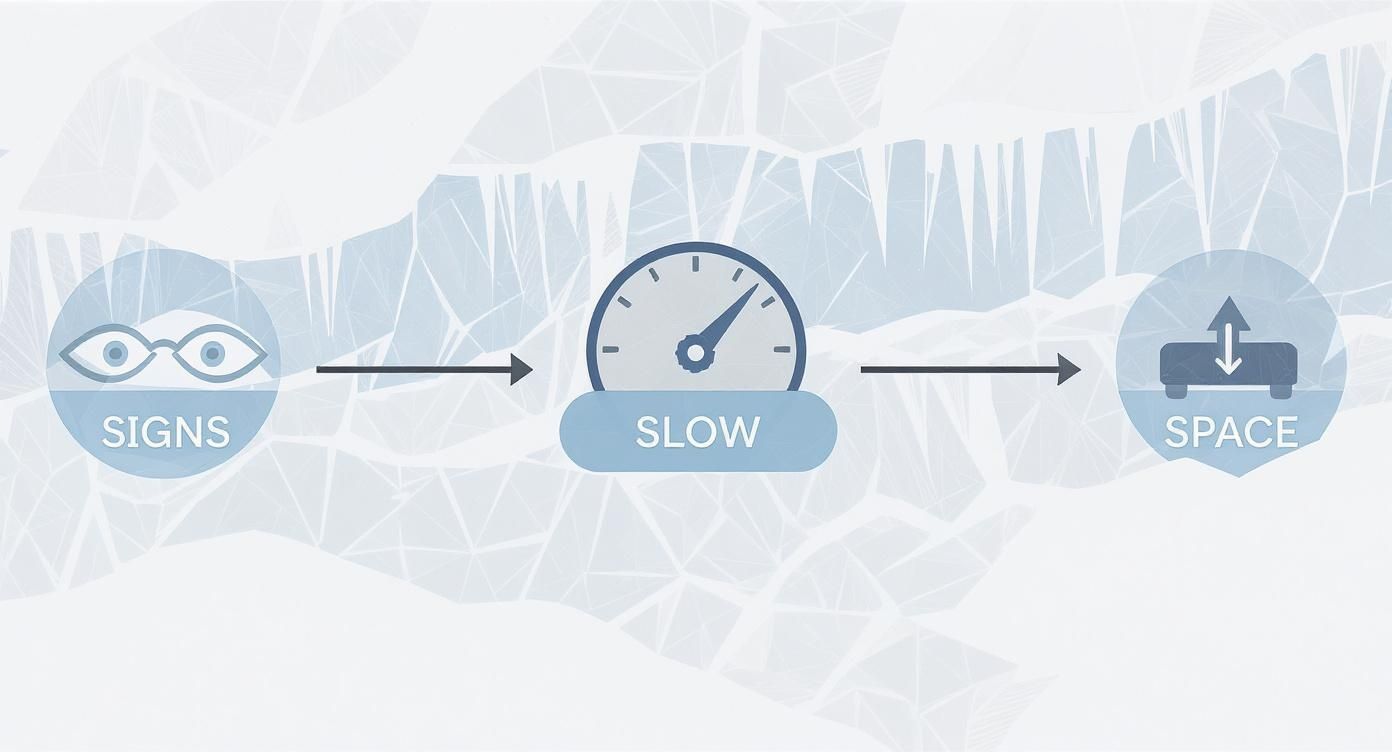
As this infographic highlights, proactive awareness—spotting danger signs, reducing speed, and maintaining ample following distance—is the foundation of safety on slick roads.
Steer Through the Slide
With your feet off the pedals, focus entirely on steering. Your sole objective is to keep the tractor and trailer aligned.
Follow this rule: steer gently in the direction you want the front of the truck to go. If the rear of your tractor starts to slide right, make a small, smooth steering correction to the right to "catch" the slide and straighten the vehicle.
Avoid sudden, jerky movements at all costs. Overcorrection is a common and dangerous error that can whip the trailer in the opposite direction, inducing an unrecoverable jackknife. Keep your eyes focused far down the road on your intended path, not on the immediate hazard you are trying to avoid.
How to Handle a Jackknife
A jackknife begins when you see your trailer start to overtake the tractor in your mirror. Your response must be immediate yet controlled.
- Get Off the Brakes: This cannot be overstressed. Braking will accelerate the jackknife.
- Steer Into the Skid: If the trailer is sliding to your left, turn the steering wheel slightly to the left. Follow the direction of the slide.
- Consider Smooth Power Application: This is an advanced technique for experienced drivers. In some situations, a very gentle and smooth application of the accelerator can help pull the tractor and trailer back into alignment. This should only be attempted if you have sufficient space and a clear path.
The most critical thing to remember is this: less is more. A gentle touch on the wheel and a level head will do more to save your rig than any panicked, aggressive move ever will.
The type of cargo you are hauling also affects vehicle dynamics. A loaded flatbed will behave very differently in a skid compared to an empty dry van. To understand these specifics better, you can explore the unique challenges of flatbed truck trailer transport. Ultimately, building the correct muscle memory through training is what transforms a potential disaster into a controlled recovery.
Post-Skid Recovery and Assessment
https://www.youtube.com/embed/gp4asX07e7I
Successfully straightening your rig after a black ice skid is only the first step. The subsequent adrenaline rush can impair judgment as much as the ice itself. Your heart rate is elevated, your hands may be shaking, and your decision-making abilities are compromised.
Your immediate priority is to find a safe location to pull over. Do not attempt to continue driving.
Operating a commercial vehicle while in an agitated state creates an unacceptable risk. Identify the next exit, a well-lit truck stop, or a wide, stable shoulder far from moving traffic. Activate your hazard lights and take a moment to compose yourself. This is not a sign of weakness; it is a professional's method of managing a critical situation completely.
Conducting a Post-Incident Inspection
Once safely parked, perform a thorough walk-around inspection. The forces exerted on your equipment during a slide are immense. You cannot assume everything is undamaged simply because there was no collision.
Focus on these critical systems:
- Tires and Rims: Inspect for any new damage, such as flat spots from a locked-wheel slide or cracks in the rims.
- Brakes and Air Lines: Visually inspect brake chambers, slack adjusters, and all visible air lines. A sudden jolt can dislodge a fitting or create a new air leak.
- Load Security: If you are hauling cargo on an open deck or flatbed, re-verify all securement points. A violent skid can shift the load, compromising its stability. Double-check every strap, chain, and binder.
This inspection is about identifying any new problem that the black ice truck incident may have introduced. A minor mechanical issue can escalate into a major failure down the road.
The most overlooked part of post-skid recovery is the driver. Your truck might be perfectly fine, but you need to check on yourself. Take five minutes. Breathe deep, have some water, and let that adrenaline burn off before you even think about rolling again.
Assessing Your Own Condition
After clearing the truck, you must assess your own fitness to continue driving. A near-miss on black ice is a significant stress event. It is normal to feel shaken.
Before re-engaging the clutch, you must be confident that your focus has returned and you are mentally prepared to resume driving.
If you still feel agitated, take a longer break. A fifteen-minute delay is infinitely preferable to causing an accident due to impaired focus. A true professional manages all aspects of the situation—the environment, the equipment, and themselves—to ensure the remainder of the transport is completed safely.
Answering Your Questions About Black Ice
Even experienced transport professionals have questions about black ice. Maintaining a healthy respect for this hazard is crucial for safety. Here are answers to common questions, focusing on practical, on-road applications.
Can All This New Technology Save Me on Ice?
Modern safety technologies like ABS and traction control are valuable but are not infallible. Do not allow them to create a false sense of security. These systems require some level of tire grip to function. On a sheet of black ice where friction is near zero, they cannot create traction. Technology may help you manage a skid once traction is partially regained, but it cannot prevent the initial loss of control. Your primary defense remains fundamental: reduce speed, increase following distance, and operate the vehicle with extreme smoothness. Never use cruise control when there is any possibility of ice.
Should I Follow in the Tire Tracks of the Truck Ahead?
This is a high-risk gamble. While the tracks may sometimes offer slightly better traction where slush has been displaced, they can also become polished into slick, icy ruts that are more dangerous than the surrounding surface. A more reliable method is to observe the tire spray from the vehicle ahead. If their spray suddenly ceases while the road surface still looks wet, it is a strong indicator of ice. It is always safer to maintain a large following distance and interpret the road conditions for yourself.
The single most important action when your truck hits black ice is to do nothing. It sounds completely wrong, but the best initial reaction is to make no sudden moves. Immediately take your feet off the accelerator and the brake. Your goal is to be smooth and gentle, allowing the tires the best chance to regain traction as they roll over theice.
Okay, I Hit Ice. What's the Absolute First Thing I Do?
When you feel the telltale "float" of tires on ice, you must suppress the instinct to brake or make a sharp steering input. The top priority is to remain calm and minimize control inputs.
- Take your foot off the fuel.
- Take your foot off the brake.
- Do not touch the clutch.
Allow the truck to coast. This keeps the wheels rolling, which is essential for regaining any available traction. Keep the steering wheel pointed in your intended direction of travel, making only minimal, smooth corrections if absolutely necessary. A calm mind and a light touch are your most effective tools for navigating an ice patch successfully.
Navigating the complexities of heavy vehicle transport requires expertise and meticulous planning, especially in challenging conditions. We Will Transport It offers reliable, nationwide shipping solutions for vehicles, heavy equipment, and oversized loads, ensuring your assets are handled with professional care.

